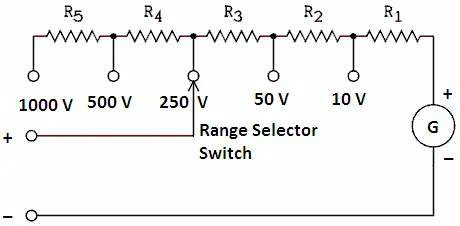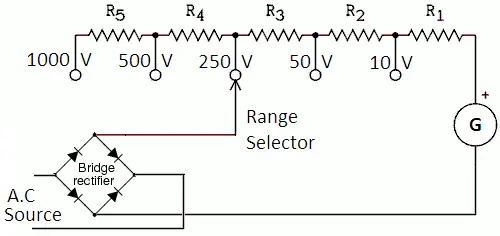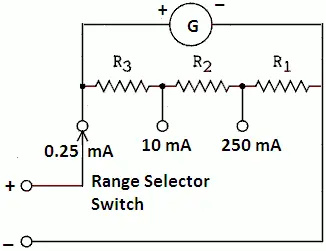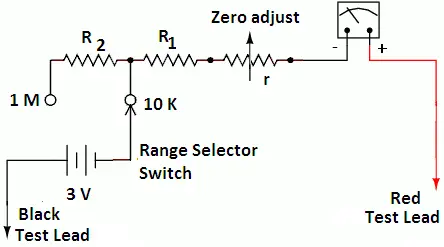An analog multimeter is the most commonly used instrument by technicians and engineers in the laboratory, as well as other repair works. As it is clear from the name of this instrument, it can make many (multi) measurements with reasonable accuracies such as AC and DC voltages, currents, and resistances.
Since it is a milliammeter, voltmeter, and ohmmeter combined, it is also called an AVO meter. It has various ranges of voltage, resistance, and current.
Multimeter Working Principle
In this meter, an electromechanical part (called D’Arsonval movement) is used to move the pointer on a graduated scale to show the readings of the measured quantity. It operates on the d’Arsonval galvanometer principle.
Basically, it is a permanent magnet-moving coil galvanometer. There is an iron-cored coil pivoted on two jeweled bearings. The coil is wound on an aluminum former or bobbin. And this coil is free to rotate in the field of a permanent magnet. An aluminum pointer is attached to the coil and bobbin assembly and moves on a graduated scale.
There are two spiral springs attached to the coil assembly at the top and bottom, which provide a path for the flow of current and controlling torque.
A multimeter can measure voltage, current, and resistance for which its galvanometer is converted to a voltmeter, ammeter, and ohmmeter with the help of suitable circuits incorporated in it. The galvanometer used in a multimeter has always its pointer resting at zero position on the extreme left end various measurements are made on a multimeter as explained below:
Voltage Measurement by Multimeter
Generally, a galvanometer has a current sensitivity of the order of 0.1 mA and a small internal resistance of about 500 ohms. As such, it cannot measure high voltages. To measure high voltages, its range is extended by connecting a high resistance in series with the galvanometer as shown in the figure.

If the galvanometer resistance is denoted by G, Ig is the full-scale deflection current and the voltage to be measured is V volts, then the value of series resistance RS is determined as under,
V = IgRs + IgG
or Rs = (V – IgG)/Ig
This series resistance is also called the multiplier. The voltage range can be increased by increasing the number or value of multipliers. Either a selector switch is provided to select different ranges or some sockets indicating the voltage range are provided in a multimeter.
While making, the measurement one lead is inserted in the common socket and the other lead in the required voltage range socket.
The multimeter can also measure AC. For this purpose, a full-wave rectifier is incorporated into the multimeter. The rectifier converts AC into DC for application to the galvanometer.

The desired AC voltage range is selected by the selector switch or sockets. When AC voltage is to be measured, the switch should be thrown to AC or the test lead should be inserted in the AC socket. The range of the multimeter should also be suitably selected.
Current Measurement by Multimeter
The same galvanometer can be used for measuring current when it is converted into an ammeter by connecting a small resistance Rsh in parallel with the meter, as shown in the figure.

If G is the internal resistance of the meter, Ig is its full-scale deflection current and I is the total current to be measured, then the value of shunt resistance Rsh required can be found as under:
(I – Ig)Rsh = IgG
or Rsh = IgG/(I – Ig)
The range of the ammeter can be extended to any value within limits by reducing the value of shunt resistance. Some low resistances are connected in parallel with the meter through a selector switch, as shown in the figure. The desired range can be selected by moving the selector switch to a particular position.
If the total current to be measured, I is very high, the value of shunt resistance required Rsh becomes very low, which is sometimes practically not possible. In this case, connections are so arranged that as we move from the low range to the higher range, the meter resistance is also increased with the decrease in the value of shunt resistance.
Resistance Measurement by Multimeter
The same basic instrument can be used as an ohmmeter to measure resistances. In this circuit, an internal battery is connected in series with the meter through an adjustable resistance r and fixed resistances.
The fixed resistances limit the current within the desired range, and the variable resistance r is used for zero adjustments.

The resistance to be measured (test resistance) is connected between test leads. The current flowing through the circuit depends upon the resistance of the test piece.
The deflection of the needle indicates current, but the scale is calibrated in ohms to give the value of resistance directly. The ohmmeter is generally made multi-range instrument by using different values of fixed resistances.
To measure resistance by the multimeter, a suitable range is selected. Then the meter leads are shorted, and variable resistance r is adjusted to give full-scale deflection.
Under this condition, the resistance between test leads is zero; therefore, the scale of the ohmmeter indicates zero on the extreme right end. Then the resistance under measurement is connected between terminals test leads.
Sensitivity of Multimeter
The sensitivity of a multimeter may be defined as the resistance offered per volt of full-scale deflection by it. It is an essential characteristic of a multimeter. If the sensitivity of a multimeter is high, it means it has high internal resistance.
When such a meter is connected to the circuit to measure voltage, it will draw negligible current and, thus will measure the correct voltage. The sensitivity of a multimeter varies from 8k ohm per volt to 20k ohm per volt.